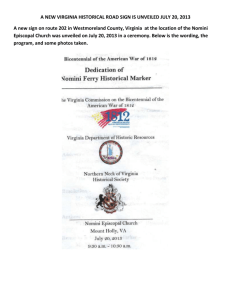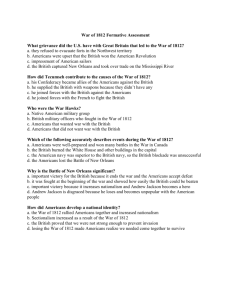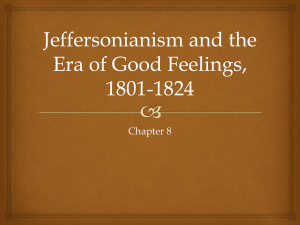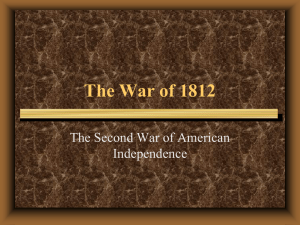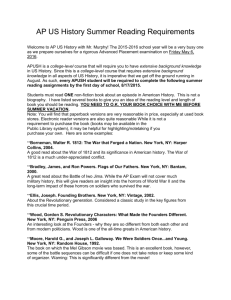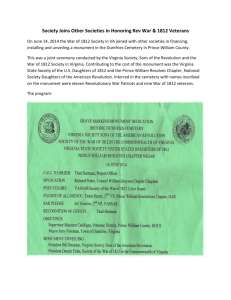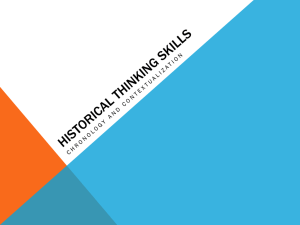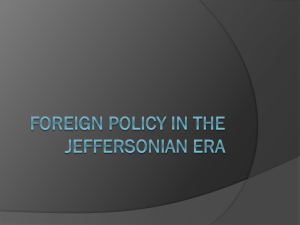War of 1812 - Midland Independent School District
advertisement
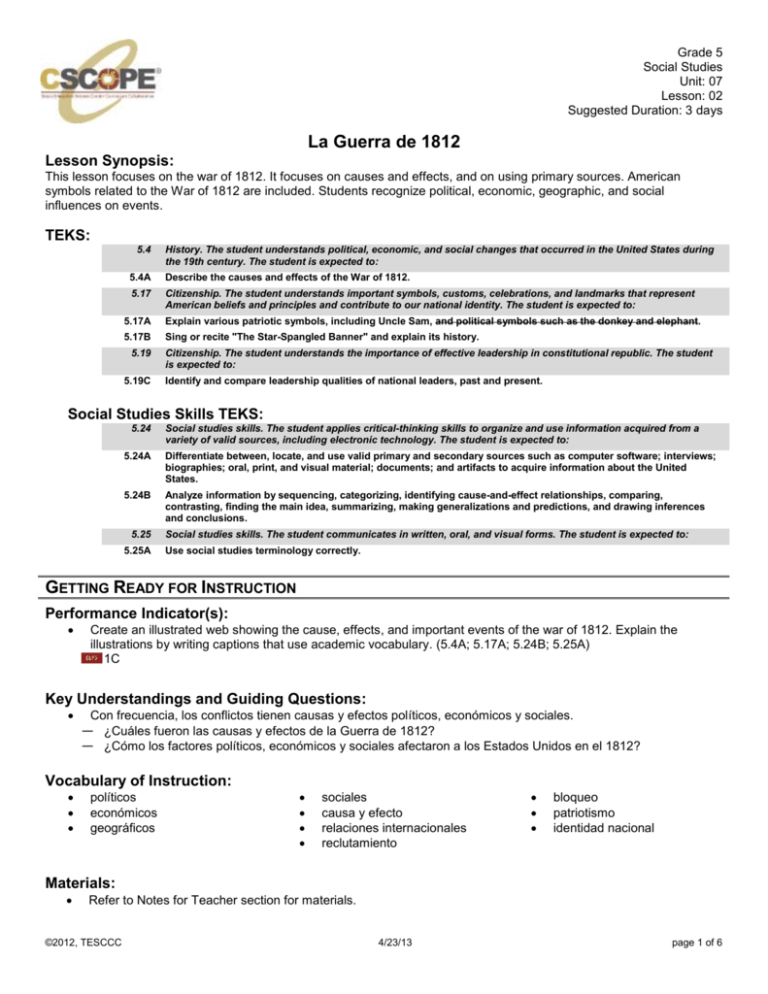
Grade 5 Social Studies Unit: 07 Lesson: 02 Suggested Duration: 3 days La Guerra de 1812 Lesson Synopsis: This lesson focuses on the war of 1812. It focuses on causes and effects, and on using primary sources. American symbols related to the War of 1812 are included. Students recognize political, economic, geographic, and social influences on events. TEKS: 5.4 History. The student understands political, economic, and social changes that occurred in the United States during the 19th century. The student is expected to: 5.4A Describe the causes and effects of the War of 1812. 5.17 Citizenship. The student understands important symbols, customs, celebrations, and landmarks that represent American beliefs and principles and contribute to our national identity. The student is expected to: 5.17A Explain various patriotic symbols, including Uncle Sam, and political symbols such as the donkey and elephant. 5.17B Sing or recite "The Star-Spangled Banner" and explain its history. 5.19 5.19C Citizenship. The student understands the importance of effective leadership in constitutional republic. The student is expected to: Identify and compare leadership qualities of national leaders, past and present. Social Studies Skills TEKS: 5.24 Social studies skills. The student applies critical-thinking skills to organize and use information acquired from a variety of valid sources, including electronic technology. The student is expected to: 5.24A Differentiate between, locate, and use valid primary and secondary sources such as computer software; interviews; biographies; oral, print, and visual material; documents; and artifacts to acquire information about the United States. 5.24B Analyze information by sequencing, categorizing, identifying cause-and-effect relationships, comparing, contrasting, finding the main idea, summarizing, making generalizations and predictions, and drawing inferences and conclusions. 5.25 5.25A Social studies skills. The student communicates in written, oral, and visual forms. The student is expected to: Use social studies terminology correctly. GETTING READY FOR INSTRUCTION Performance Indicator(s): Create an illustrated web showing the cause, effects, and important events of the war of 1812. Explain the illustrations by writing captions that use academic vocabulary. (5.4A; 5.17A; 5.24B; 5.25A) 1C Key Understandings and Guiding Questions: Con frecuencia, los conflictos tienen causas y efectos políticos, económicos y sociales. — ¿Cuáles fueron las causas y efectos de la Guerra de 1812? — ¿Cómo los factores políticos, económicos y sociales afectaron a los Estados Unidos en el 1812? Vocabulary of Instruction: políticos económicos geográficos sociales causa y efecto relaciones internacionales reclutamiento bloqueo patriotismo identidad nacional Materials: Refer to Notes for Teacher section for materials. ©2012, TESCCC 4/23/13 page 1 of 6 Grade 5 Social Studies Unit: 07 Lesson: 02 Attachments: Handout: Political, Economic, Geographic, and Social Characteristics Chart (1 per student) Handout: Blank PEGS Chart (1 per student) Handout: The War of 1812 (1 per student) Teacher Resource: PEGS Chart KEY Handout: Star-Spangled Banner (1 per student) Handout: Symbols of the New Nation (1 per group) Teacher Resource: Creating a Mind Map Resources and References: US Army band: http://bands.army.mil/music/nationalanthem.asp Advance Preparation: 1. Become familiar with content and procedures for the lesson, including the causes and effects of the War of 1812, and the categories of political, economic, geographic, and social. 2. Refer to the Instructional Focus Document for specific content to include in the lesson. 3. Select appropriate sections of the textbook and other classroom materials that support the learning for this lesson. 4. Preview materials and websites according to district guidelines. 5. Prepare materials and handouts as necessary. Background Information: Though the American Revolution ended with the 1783 Treaty of Paris, there were still many unresolved issues and tensions between the two countries. One of these was impressment, the continued hijacking of American sailors onto British ships, declaring the sailors British deserters from the British navy. Napoleon had come to power in France in 1802, with the goal of conquering Europe. One of his main goals was to disrupt the British economy, including by disrupting shipping trade. Britain declared war on France. Napoleon blockaded British ports and declared all ports of Europe closed to British vessels. Britain retaliated by preventing imports from entering French ports without first stopping in Britain to pay a duty. America took a stand to support nations who stopped the embargo of American ships. Napoleon had indicated that he would do so, and so America took a more aggressive position against the British as a result, which led to complications when Napoleon did not actually follow through on his promise to not stop American ships. The situation deteriorated, and soon Britain and the United States were at war. In this way the War of 1812 was an outgrowth of the Napoleonic Wars. It was really the nation’s first major foray into international relations. Other situations added to the situation as well. Before the American Revolution, the British had forts west of the Appalachian Mountains, in land formerly claimed by Britain. But the British did not abandon those forts, even though this was part of the 1783 Treaty of Paris. In 1812, the British still occupied their forts, preventing settlers from moving west and protecting/supporting Indians, who also did not want the Americans to move west. James Madison was president in 1812. Having served as Secretary of State under Jefferson, Madison became president in 1808. He was author of the constitution, a strong nationalist, and supporter of a powerful central government. In 1812 the United States declared war on Britain. Canada was a British Colony, and American forces invaded Canada, attacking its capital (then York, now known as Toronto) and burned the Parliament building there. The British defeated Napoleon in Europe in 1814 and turned their attention to the United States. In revenge for burning the capital of its colony, Canada, British troops attacked the United States capital of Washington, D.C. They burned the Capitol Building and destroyed the Library of Congress. Then they headed for the White House, where Dolley Madison packed the White House valuables, including Gilbert Stuart’s portrait of George Washington, before fleeing ahead of the invading forces who set fire to the White House before moving toward Baltimore. It was at Fort McHenry in Baltimore that Francis Scott Key, while arranging for the release of a prisoner, wrote the poem ©2012, TESCCC 4/23/13 page 2 of 6 Grade 5 Social Studies Unit: 07 Lesson: 02 “The Defense of Fort McHenry,” the words of which became the lyrics to the Star-Spangled Banner, which became the national anthem of the United States. The lack of timely communication was involved in both the beginning and end of the War of 1812. It is likely that if word had gotten to the American leaders when President Madison sent a war message to Congress on June 1, 1812, that Britain was revoking (on June 23) those restrictions on trade that had angered the Americans that the invasion of Canada would not have taken place. Likewise, it is likely that if communication had been more timely and the forces at New Orleans had known that the Treaty of Ghent had been signed on December 24, 1814, the Battle of New Orleans would not have taken place on January 8, 1815. The War of 1812 is sometimes referred to as America’s Second War for Independence because by winning this war the United States solidified its independence from Britain and set itself as a force to be reckoned with in the world. The War of 1812 is often skimmed over, but several key events in American history occurred at the time. The United States “grew up” and became a recognized entity in the world; the Star-Spangled Banner was written; the story of Dolley Madison became part of our nation’s heritage; and Andrew Jackson, who later became the 7 th president, became a national figure at the Battle of New Orleans. GETTING READY FOR INSTRUCTION SUPPLEMENTAL PLANNING DOCUMENT Instructors are encouraged to supplement and substitute resources, materials, and activities to differentiate instruction to address the needs of learners. The Exemplar Lessons are one approach to teaching and reaching the Performance Indicators and Specificity in the Instructional Focus Document for this unit. Instructors are encouraged to create original lessons using the Content Creator in the Tools Tab located at the top of the page. All originally authored lessons can be saved in the “My CSCOPE” Tab within the “My Content” area. INSTRUCTIONAL PROCEDURES Instructional Procedures Notes for Teacher NOTE: 1 Day = 50 minutes Suggested Day 1 ‒ 5 minutes Materials: Audio of the Star-Spangled Banner US Army band: http://bands.army.mil/music/nationalanthem. asp ENGAGE – Listen 1. Play the Star-Spangled Banner. EXPLORE – War of 1812, PEGS 1. Distribute the Handout: Political Economic Geographic and Social Chart. Use the Lewis and Clark expedition or the American Revolution as an example to help students understand political, economic, geographic, and social factors that impact events. 2. Distribute the Handout: The War of 1812. 3. Read the Handout: The War of 1812 while students follow along. Add more information as appropriate to present the story of the War of 1812. (See the Handout: The War of 1812 and Background Information above.) 4. Students listen and follow along, highlighting information related to the political, economic, geographic and social causes and effects of the war. 5. Using the handout and the chart for reference, students discuss what they learned about the War of 1812 including what caused the war and the influence of international relations on the actions of the United States. Suggested Day 1 (continued) ‒ 30 minutes Materials: highlighters Attachments: Handout: Political, Economic, Geographic, and Social Characteristics Chart (1 per student) Handout: Blank PEGS Chart (1 per student) Handout: The War of 1812 (1 per student) Teacher Resource: PEGS Chart KEY TEKS: 5.4A; 5.17A; 5.24B; 5.25A Instructional Note Be aware that some causes and effects may fit into more than one of the categories, such as re-building Washington, D.C. could be political, economic, geographic and social. 6. Distribute the Handout: Blank PEGS Chart and lead ©2012, TESCCC 4/23/13 page 3 of 6 Grade 5 Social Studies Unit: 07 Lesson: 02 Instructional Procedures Notes for Teacher students in a discussion of the information on the War of 1812. 7. Create a class chart using input from students about the political, economic, geographic, and social factors related to the war. (See the Teacher Resource: PEGS Chart KEY for suggestions of what could be included in the discussion.) Students add to and adjust information on their charts, too. 8. Help students understand the War of 1812 by facilitating a discussion where students list the major issues leading to the war, the major events during the war, and the lasting effects of the war. (See chart at left and see also the IFD) President Madison led the nation through the war. One of the effects of the war was the elevation of Andrew Jackson who, as a result of his leadership during the War of 1812, became a national hero and would become the 7th president of the United States. 9. Students deepen their understanding of issues and events of the War of 1812 by reading appropriate sections of the textbook and other classroom materials as homework. EXPLAIN – Illustrate, Use a Word Bank 1. Students illustrate important issues and events of the War of 1812 and explain their drawings to a classmate using academic vocabulary from a word bank. Suggested word bank (add words from classroom discussion as well) political economic social geographic impressment embargo blockade lyrics international relations occupy colony EXPLORE – Star-Spangled Banner Causes Continued impressment British trade restrictions British occupied forts War of 1812 Attack on Canada Burning of Washington DC StarSpangled Banner Andrew Jackson Effects National pride, patriotism, stature, national identity Increase manufacturing and trade Peace but no cession of land Events, issues, people of the War of 1812 that may come up in discussion: Fort McHenry, Battle of Chesapeake, War Hawks, Federalists, invasion of Canada, Old Ironsides (Constitution), Battle of York (Toronto), Battle of New Orleans, Tecumseh, Andrew Jackson, Dolley Madison, President James Madison, Suggested Day 1 (continued) ‒ 15 minutes Materials: paper for drawing Suggested Day 2 ‒ 25 minutes Materials: highlighters (optional) 1. Play the national anthem. 2. Show pictures of the Star-Spangled Banner, Fort McHenry, etc. 3. Introduce a discussion of national symbols by asking: We played the national anthem at the beginning of class yesterday and today. Why? What does it have to do with what we are studying? Attachments: Handout: Star-Spangled Banner (1 per student) Instructional Note Pictures of the original manuscript are available on the Smithsonian website. 4. Distribute the lyrics of the national anthem (See Handout: Star-Spangled Banner.) 5. Students draw a vertical line along the right side of the lyrics to create a 2-column note organizer. ©2012, TESCCC 4/23/13 page 4 of 6 Grade 5 Social Studies Unit: 07 Lesson: 02 Instructional Procedures Notes for Teacher 6. Students read through the lyrics and use a 2-column notes strategy to begin analysis of the lyrics, underlining or highlighting interesting phrases or words (including words they do not understand) in the left column and writing questions, comments, connections in the right column. 7. With students in pairs to encourage dialogue, facilitate a discussion of what they found in the national anthem (provide brief definitions of words/terms they do not know). 8. Conclude the discussion by again showing pictures of the Star-Spangled Banner (displayed at the National Museum of American History at the Smithsonian Institution) and using words such as: The Star-Spangled Banner evoked feelings of pride, patriotism, and courage. It recognized the feelings of resilience Americans felt as the new United States, a fledgling country, in battle with the world’s “superpower” of the day. EXPLAIN – Sing, Recite Suggested Day 2 (continued) ‒ 5 minutes 1. Students sing or recite the Star-Spangled Banner and explain its history to a partner. EXPLORE – Symbols from War of 1812 1. Distribute the Handout: Symbols of the New Nation. 2. Begin a discussion of other symbols of the new nation with connections to the War of 1812. The ship the USS Constitution (Old Ironsides) became a symbol of America’s strength and victory in the War of 1812. Other symbols with ties to the War of 1812 include Uncle Sam, the White House, the Star-Spangled Banner, and the Capitol building. Suggested Day 2 (continued) ‒ 20 minutes Materials: Information about the USS Constitution, Uncle Sam, the White House, the Capitol, and the StarStudded Banner Attachments: Handout: Symbols of the New Nation (1 per group) 3. Divide students into groups of 5. 4. Distribute the Handout: Symbols of the New Nation to each group. 5. Each student in the group receives one symbol page to investigate. Students read and learn about the symbol using the handout, the textbook, and other appropriate information. 6. In their groups, students each share what they have learned. EXPLAIN – 3-2-1 Suggested Day 3 ‒ 5 minutes 1. To review learning for this lesson, students list 3 symbols of the United States that are related to the War of 1812 2 factors that led to the War of 1812 (identified as political, economic, social, or geographic) 1 result of the War of 1812 ©2012, TESCCC 4/23/13 page 5 of 6 Grade 5 Social Studies Unit: 07 Lesson: 02 Instructional Procedures Notes for Teacher ELABORATE – Summarize Learning Suggested Day 3 (continued) ‒ 10 minutes 1. Help students summarize their learning by applying what they have learned about the War of 1812 to answer the guiding questions in support of the Key Understanding. Conflicts often have political, economic, and social causes and effects. — What were the causes and effects of the War of 1812? — How did political, economic, social, and geographic factors affect the United States in 1812? EVALUATE – Performance Indicator Create an illustrated web showing the causes, effects and important events of the war of 1812. Explain the illustrations by writing captions that use academic vocabulary. (5.4A; 5.17A; 5.24B; 5.25A) 1C 1. Distribute paper for students to use to create their illustrated web. Suggested Day 3 (continued) ‒ 35 minutes Materials: Paper for drawing Attachments: Teacher Resource: Creating a Mind Map PI TEKS: 5.4A; 5.17A; 5.24B; 5.25A 2. Students first create the web using words and then add illustrations and captions. 3. For one way to create a web (mind map) see the Teacher Resource: Creating a Mind Map PI ©2012, TESCCC 4/23/13 page 6 of 6
